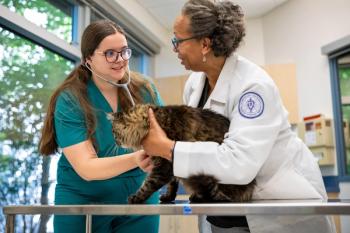
NY Vet: The Best Approach to Treating Inappetence
When a patient presents with inappetence, understanding the underlying cause is vital to providing successful long-term management.
Few would dispute that being presented with a patient that refuses to eat is frustrating and disheartening. And while the immediate reaction—and likely request from the pet owner—is to get the cat or dog to eat as soon as possible, providing your patient with the best possible care requires a comprehensive, thoughtful approach.
During his presentation at the 2018 NY Vet Conference in New York City, Stanley L. Marks, BVSc, PhD, DACVIM, provided a detailed overview of inappetence, its causes, and the available therapeutic options.
Reviewing the Basics
Dr. Marks first stressed the importance of understanding the terms commonly used to describe appetite control issues and reviewed their definitions as they apply to veterinary medicine. Often, he explained, these terms are misused when describing a patient, which can do a great deal of disservice.
- Anorexia refers to the complete lack of food intake. “A patient cannot be partially anorexic,” he said. “That term is nonsensical and should not be used.”
- Hyporexia indicates a reduction in food intake, regardless of the reason or cause.
- Dysrexia refers to the distortion of normal appetite or eating patterns. An example of a patient with dysrexia, Dr. Marks explained, would be a dog that refuses to eat its regular commercial diet but has no problem eating cooked chicken and rice that the pet owner offers as an alternative.
Beyond the terminology used to describe a patient’s condition, Dr. Marks urged attendees to ensure that they are familiar with the fundamental causes of inappetence and how those causes present in anorexic or hyporexic patients.
“Take pain, for example,” he said. “ Pain is a very important cause of inappetence in our patients and is being increasingly recognized. I am really happy to see that pain scores are now used by many practitioners in many hospitals.” Being able to assess patient pain helps guide the treatment process.
RELATED:
- FDA to Veterinarians: Use Approved Mirtazapine Product
- Mirtazapine for Appetite Stimulation in Cats
Other triggers to familiarize yourself with include nausea, obtundation, stress, and food aversion. In patients with food aversion, Dr. Marks cautioned veterinarians against force-feeding the patient, particularly a cat, because it will have the opposite effect. “What you will find is that when the cat has fully recovered it will actively avoid the diets you tried to force feed,” Dr. Marks said.
When you have an animal that presents with anorexia or hyporexia, the automatic response should not be to find an appropriate appetite stimulant and consider it a victory. Instead, Dr. Marks said it is vital to understand what is causing the condition. “Appetite stimulants are not addressing the reason for the patient’s inappetence,” he said. “Rather they are a Band-aid that can be used while trying to make the diagnosis.”
Therapeutic Considerations
There is no one-size-fits-all approach to inappetence, Dr. Marks noted. Yet when addressing a patient that will not eat, it is important to consider metabolic alterations, including hypertension, hypokalemia, severe anemia, and vomiting. Additionally, the veterinarian should be able to address any psychological stressors and do whatever possible to increase the palatability of the diet, including recognizing that aroma and texture are as important as taste. Lastly, make sure you thoroughly review all medications the patient is taking to rule out the possibility that a drug is causing the inappetence.
Appetite Stimulants
“First and foremost,” Dr. Marks explained, “appetite stimulants are perfectly viable considerations for short-term treatment while you are working up that particular patient.” They should also be considered for patients with persistent and moderate hyporexia without any physical impediment (such as trouble swallowing); when behavioral or environmental causes of anorexia are suspected and dietary manipulation has been unsuccessful; to support nutritional intake in chronically ill animals suffering from kidney disease or cancer; and when trying to overcome food aversions once the underlying cause of the anorexia has been resolved.
The only appetite stimulants on the market that have been FDA approved are
Enteral Feeding Devices
Enteral feeding devices can be very important to the treatment of anorexia and hyporexia, and veterinarians should familiarize themselves with when and how to use these devices. When used correctly, Dr. Marks said, they are safe, well tolerated, and lead to far fewer adverse effects when compared with gastronomy tubes.
Conclusions
Inappetence is very prevalent among veterinary patients, Dr. Marks reiterated during his conclusion. It affects their morbidity and outcome. To achieve the best results, he explained, treat the underlying cause when possible, recognize that you should be proactive about meeting the patient’s nutritional requirements, and strive for a multimodal approach to treatment.
Newsletter
From exam room tips to practice management insights, get trusted veterinary news delivered straight to your inbox—subscribe to dvm360.





